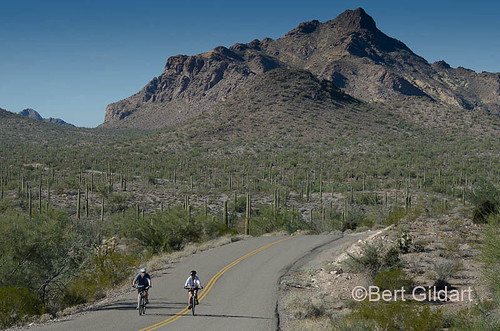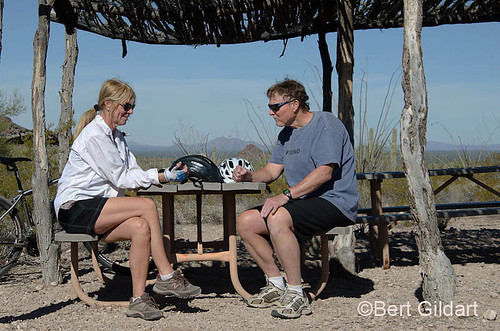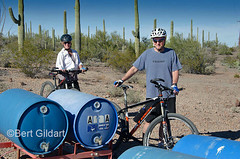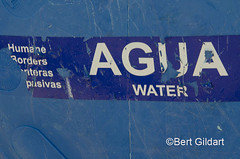Organ Pipe’s Humane Borders — But Are they Too Humane?
©Bert Gildart: Shortly after Don and Nancy Dennis and I turned our bicycles onto the Puerto Blanco road in Organ Pipe National Monument, a patrol car passed us to be followed a few moments later by a surveillance helicopter. Quickly they assessed our presence, and satisfied that we were not undocumented immigrants or drug runners, they accelerated on.

Only five miles of the 50-mile-long Puerto Blanco road are open now to legal American residents. Unfortunately the rest is closed.
For a while, we watched the helicopter, for it seemed focused on a low pass in the surrounding mountains. Back and forth the helicopter flew, and my companions and I discussed the difficulty of their work as we rode. If immigrants — or drug runners — were camouflaged, it seemed they could evade rangers and the border patrol, and apparently many do, for the internet suggests that hundreds stream through the park on an annual basis. On a national basis, along our entire border, the internet reports that over a million Mexicans attempt to enter the United States — illegally. (Note: I know my opinion on this seems to shift, but conditions here are persuasive and in your face. Other thoughts may be needed now for balance.)
CLOSED TO LEGAL AMERICANS
America has its problems and this beautiful park epitomizes the complexities, for it has experienced some tragic moments. In 2002 a drug runner killed a much admired ranger and, then, over the years undocumented immigrants have perished from lack of water. That, too, is tragic, but of course, they should not have been here in the first place. Because of their activities vast portions of this once accessible park have been closed, and that doesn’t seem right, for Organ Pipe is such a unique portion of America that it has, in fact, been declared a world heritage center, meaning that there is no place else in the world like it. (Night Photography in Organ Pipe.) But as unique as this park may be, sections are considered dangerous and you can no longer visit these beautiful sections of this the Sonoran Desert.
L To R: Compassionate water tanks help create “humane borders.” Sign at water tanks about man who perished. Yet another sign at water tanks noting that Americans create humane border crossing, essentially for illegal Mexicans who depart Mexico because of impoverished working conditions. That’s tragic, but the population of America has now increased by several million, and in many cases, their problems now become ours.
The bike ride that Don, Nancy and were making illustrates one of the restrictions – and some of the accommodations we’ve had to make. Fifteen years ago Janie and I drove this rode and at the time the entire 50-mile-long length of the Puerto Blanco road was open, but today, except for the first five miles, the road is closed. Percentage wise, that means that 69 percent of this park is closed, including beautiful Quitobaquito springs, which Janie and I toured several years ago, but only with an armed escort.
HUMANE BORDERS
After about an hour’s ride, Don, Nancy and I came to a gate closed sign and to adjacent accommodations offered by small shelters roofed with ocotillo. While we ate our lunch, the helicopter continued its surveillance. We then retraced our route, stopping this time at a series of “compassionate water tanks” located about 100 yards off the road. A huge blue flag pinpointed their presence, and we tested the fullness of the tanks by attempting to inch them up, but they wouldn’t budge, so they were obviously full of water.
Water tanks were here several years ago when I visited the area, so one of the fundamentals of human needs has been met, and for this reason it is appropriate to say that our borders – as the associated signs declare – are “Humane Borders.” And that is an American virtue.

Don and Nancy beneath roof of ocotillo shelter, representing the end of the road for us. Over half of the park lies beyond, but it is closed to Americans because of the danger posed by illegal immigrants.
But beyond that I believe the U.S. needs to protect its own resources. The population of America is increasing exponentially, and more and more pressure is being placed on our limited resources, national parks being among those resources. Superintendent Lee Baiza (whom I interviewed several years ago for a story about Organ Pipe) is doing a wonderful job, but he has his challenges. Everyone should wish him the best. I hope I can do so again, but in the meantime, I will continue to enjoy as much of this beautiful park as is possible, and hope to show images of Organ Pipe over the next few days. Legal residents are being prohibited from seeing so much of this park and that is a tragedy.
AIRSTREAM TRAVELS FIVE YEARS AGO:
————————————————————————————————–
4th ed. Autographed by the Authors
Hiking Shenandoah National Park
 Hiking Shenandoah National Park is the 4th edition of a favorite guide book, created by Bert & Janie, a professional husband-wife journalism team. Lots of updates including more waterfall trails, updated descriptions of confusing trail junctions, and new color photographs. New text describes more of the park’s compelling natural history. Sometimes the descriptions are personal as the Gildarts have hiked virtually every single park trail, sometimes repeatedly.
Hiking Shenandoah National Park is the 4th edition of a favorite guide book, created by Bert & Janie, a professional husband-wife journalism team. Lots of updates including more waterfall trails, updated descriptions of confusing trail junctions, and new color photographs. New text describes more of the park’s compelling natural history. Sometimes the descriptions are personal as the Gildarts have hiked virtually every single park trail, sometimes repeatedly.
Big Sky Country is beautiful
Montana Icons: 50 Classic Symbols of the Treasure State
![]() Montana Icons is a book for lovers of the western vista. Features photographs of fifty famous landmarks from what many call the “Last Best Place.” The book will make you feel homesick for Montana even if you already live here. Bert Gildart’s varied careers in Montana (Bus driver on an Indian reservation, a teacher, backcountry ranger, as well as a newspaper reporter, and photographer) have given him a special view of Montana, which he shares in this book. Share the view; click here.
Montana Icons is a book for lovers of the western vista. Features photographs of fifty famous landmarks from what many call the “Last Best Place.” The book will make you feel homesick for Montana even if you already live here. Bert Gildart’s varied careers in Montana (Bus driver on an Indian reservation, a teacher, backcountry ranger, as well as a newspaper reporter, and photographer) have given him a special view of Montana, which he shares in this book. Share the view; click here.
$16.95 + Autographed Copy
What makes Glacier, Glacier?
Glacier Icons: 50 Classic Views of the Crown of the Continent
![]() Glacier Icons: What makes Glacier Park so special? In this book you can discover the story behind fifty of this park’s most amazing features. With this entertaining collection of photos, anecdotes and little known facts, Bert Gildart will be your backcountry guide. A former Glacier backcountry ranger turned writer/photographer, his hundreds of stories and images have appeared in literally dozens of periodicals including Time/Life, Smithsonian, and Field & Stream. Take a look at Glacier Icons
Glacier Icons: What makes Glacier Park so special? In this book you can discover the story behind fifty of this park’s most amazing features. With this entertaining collection of photos, anecdotes and little known facts, Bert Gildart will be your backcountry guide. A former Glacier backcountry ranger turned writer/photographer, his hundreds of stories and images have appeared in literally dozens of periodicals including Time/Life, Smithsonian, and Field & Stream. Take a look at Glacier Icons
$16.95 + Autographed Copy




